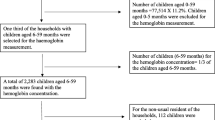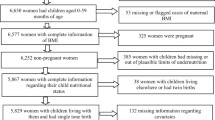Abstract
Anemia, a leading health issue affecting mothers globally, is generally prevalent among agropastoral populations. Previous research has been inconclusive regarding maternal age as a risk factor of anemia. Drawing on the models that recognize the important interaction between age and wealth, (Age-as-Leveler (AGL) and Cumulative Advantage/Disadvantage (CAD)) we evaluated whether age was a predictor for anemia and whether the effect of age depended on socioeconomic status (SES) among sedentary Ariaal agropastoralists in northern Kenya. Using archival data from 234 breastfeeding mothers, we created logistic regression models to estimate the relative importance of risk factors for mothers developing anemia. Our results suggest that in this ecological context, young mothers may have an increased risk of anemia if poor, while older mothers may have a lower risk regardless of SES. The observed pattern may be due to age-based differences in labor requirements or amount of help received for subsistence/household activities, and to attenuated SES-health associations owing to pervasive food sharing.


Similar content being viewed by others
Data Availability
The data analyzed for this study will be available in the zenodo repository upon publication.
References
Adano, W. R., and Witsenburg, K. (2005). “Once nomads settle: Assessing the process, motives, and welfare changes of settlements on Mount Marsabit.” In As pastoralists settle: Social, health, and economic consequences of the pastoral Sedentarization in Marsabit District, Kenya., edited by Fratkin E and E Roth, In Studies in Human Ecology and Adaptation, Vol. 1, 105–136. New York: Kluwer Academic/Plenum Publishers.
Balarajan, Y., Ramakrishnan, U., Ozaltin, E., Shankar, A. H., and Subramanian, S. V. (2011). Anaemia in low-income and middle-income countries. Lancet 378(9809): 2123–2135. https://doi.org/10.1016/s0140-6736(10)62304-5.
Belza, A., Ersboll, A. K., Henriksen, M., Thilsted, S. H., and Tetens, I. (2005). Day-to-day variation in iron-status measures in young iron-deplete women. British Journal of Nutrition 94(4): 551–556. https://doi.org/10.1079/bjn20051461.
Bignall, E., Paredes-Ruvalcaba, N., and Fujita, M. (2019).. During drought in northern Kenya, mothers with iron deficiency anemia were younger, but not of low socioeconomic status. University Undergraduate Research and Arts Forum, Michigan State University, East Lansing.
Bodnar, L., Cogswell, M., and McDonald, T. (2005). Have we forgotten the significance of postpartum iron deficiency? American Journal of Obstetrics and Gynecology 193(1): 36–44. https://doi.org/10.1016/j.ajog.2004.12.009.
Brunson, E. K., Shell-Duncan, B., and Steele, M. (2009). Women’s autonomy and its relationship with women’s status and children’s nutrition among the Rendille of northern Kenya. American Journal of Human Biology 21: 55–64.
Clancy, K. B., Nenko, I., and Jasienska, G. (2006). Menstruation does not cause anemia: Endometrial thickness correlates positively with erythrocyte count and hemoglobin concentration in premenopausal women. American Journal of Human Biology 18: 710–713.
Corbitt, M., Paredes Ruvalcaba, N., and Fujita, M. (2019). Variation in breast milk macronutrient contents by maternal anemia and hemoglobin concentration in northern Kenya. American Journal of Human Biology 31 (3). https://doi.org/10.1002/ajhb.23238.
Dallman, P., Yip, R., and Johnson, C. (1984). Prevalence and causes of anemia in the United-States, 1976-1980. American Journal of Clinical Nutrition 39(3): 437–445.
Dannefer, D. (2003). Cumulative advantage/disadvantage and the life course: Cross-fertilizing age and social science theory. Journals of Gerontology Series B-Psychological Sciences and Social Sciences 58(6): S327–S337. https://doi.org/10.1093/geronb/58.6.S327.
Darnton-Hill, J., N. Paragas, and T. Cavalli-Sforza. (2007). Global perspectives: Accelerating progress on preventing and controlling nutritional anemia. Edited by Kraemer K and M. Zimmermann. Nutritional Anemia. Basel, Switzerland: Sight and Life Press.
Drukker, L., Hants, Y., Farkash, R., Ruchlemer, R., Samueloff, A., and Grisaru-Granovsky, S. (2015). Iron deficiency anemia at admission for labor and delivery is associated with an increased risk for cesarean section and adverse maternal and neonatal outcomes. Transfusion 55(12): 2799–2806. https://doi.org/10.1111/trf.13252.
Fall, C. H. D., Sachdev, H. S., Osmond, C., Restrepo-Mendez, M. C., Victora, C., Martorell, R., Stein, A. D., Sinha, S., Tandon, N., Adair, L., Bas, I., Norris, S., Richter, L. M., and Cohorts Investigators (2015). Association between maternal age at childbirth and child and adult outcomes in the off spring: a prospective study in five low-income and middle-income countries (COHORTS collaboration). Lancet Global Health 3(7): E366–E377. https://doi.org/10.1016/s2214-109x.
Fratkin, E. (1998). Surviving drought and development: Ariaal pastoralists of northern Kenya. Needham Heights, MA: Allyn & Bacon Inc.
Fratkin, E. (2019). Surviving drought and development: Ariaal pastoralism of northern Kenya, Routledge, New York.
Fratkin, E., and Roth, E. A. (1996). Who survives drought? Measuring winners and losers among the Ariaal Rendille pastoralists of Kenya. In Case studies in human ecology, Springer, Boston, MA, pp. 159–173.
Fratkin, E., Roth, E. A., and Nathan, M. A. (1999). When nomads settle: The effects of commoditization, nutritional change, and formal education on Ariaal and Rendille pastoralists. Current Anthropology 40(5): 729–735. https://doi.org/10.1086/300093.
Fratkin E, Roth EA. (2005). “The setting: Pastoral sedentarization in Marsabit District, northern Kenya.” In As pastoralists settle: Social, health, and economic consequences of the pastoral Sedentarization in Marsabit District, Kenya., edited by Fratkin E and E Roth, In Studies in Human Ecology and Adaptation, Vol. 1, 29–52. New York: Kluwer Academic/Plenum Publishers.
Fratkin, E., and Smith, K. (1995). Women's changing economic roles with pastoral sedentarization: Varying strategies in alternate rendille communities. Human Ecology 23(4): 433–454.
Fratkin E, Smith K. (2005). “Women’s changing economic roles with pastoral sedentarization: Varying strategies to alternate Rendille communities.” In As pastoralists settle: Social, health, and economic consequences of the pastoral Sedentarization in Marsabit District, Kenya., edited by Fratkin E and E Roth, In Studies in Human Ecology and Adaptation, Vol. 1, 155–172. New York: Kluwer Academic/Plenum Publishers.
Fujita, M. (2008). An epidemiological and evolutionary investigation of mother-offspring vitamin A transfer. PhD Thesis, Department of Anthropology, University of Washington.
Fujita, M., E. Roth, M. Nathan, and E. Fratkin. (2005). "Sedentarization and seasonality: Maternal dietary and health consequences in Ariaal and Rendille communities in northern Kenya." In As pastoralists settle: Social, health, and economic consequences of the pastoral Sedentarization in Marsabit District, Kenya., edited by Fratkin E and E Roth, In Studies in Human Ecology and Adaptation, Vol. 1, 209–234. New York: Kluwer Academic/Plenum Publishers.
Fujita, M., Paredes Ruvalcaba, N., Wander, K., Corbitt, M., and Brindle, E. (2019). Buffered or impaired: Maternal anemia, inflammation and breast milk macronutrients in northern Kenya. American Journal of Physical Anthropology 168(2): 329–339. https://doi.org/10.1002/ajpa.23752.
Fujita, M., Shell-Duncan, B., Ndemwa, P., Brindle, E., Lo, Y. J., Kombe, Y., and O'Connor, K. (2011). Vitamin A dynamics in Breastmilk and liver stores: A life history perspective. American Journal of Human Biology 23(5): 664–673. https://doi.org/10.1002/ajhb.21195.
Fujita, M., and Wander, K. (2017). A test of the optimal iron hypothesis among breastfeeding Ariaal mothers in northern Kenya. American Journal of Physical Anthropology 164(3): 586–597. https://doi.org/10.1002/ajpa.23299.
House, J. S., Lepkowski, J. M., Kinney, A. M., Mero, R. P., Kessler, R. C., and Herzog, A. R. (1994). The social-stratification of aging and health. Journal of Health and Social Behavior 35(3): 213–234. https://doi.org/10.2307/2137277.
Kamruzzaman, M., Rabbani, M. G., Saw, A., Abu Sayem, M., and Hossain, M. G. (2015). Differentials in the prevalence of anemia among non-pregnant, ever-married women in Bangladesh: Multilevel logistic regression analysis of data from the 2011 Bangladesh demographic and health survey. Bmc Womens Health 15. https://doi.org/10.1186/s12905-015-0211-4.
Leopold, L., and Leopold, T. (2018). Education and health across lives and Cohorts: A study of cumulative (dis)advantage and its rising importance in Germany. Journal of Health and Social Behavior 59(1): 94–112. https://doi.org/10.1177/0022146517751206.
Lone, F. W., Qureshi, R. N., and Emanuel, F. (2004). Maternal anaemia and its impact on perinatal outcome. Tropical Medicine & International Health 9(4): 486–490. https://doi.org/10.1111/j.1365-3156.2004.01222.x.
Lynch, S. (2007). Iron metabolism. Edited by K. Kraemer & M. Zimmermann. Nutritional Anemia. Basel, Switzerland: Sight and Life Press.
Ma, Q. Y., S. K. Zhang, J. Liu, Q. M. Wang, H. P. Shen, Y. P. Zhang, and M. Liu. (2017). Study on the prevalence of severe Anemia among non-pregnant women of reproductive age in rural China: A large population-based cross-sectional study. Nutrients 9(12):1298. https://doi.org/10.3390/nu9121298.
Miller, E. (2010). Maternal hemoglobin depletion in a settled northern Kenyan pastoral population. American Journal of Human Biology 22(6): 768–774.
Miller, E. (2016). The reproductive ecology of iron in women. American Journal of Physical Anthropology 159: 172–195.
Miller, J. L. (2013). Iron deficiency Anemia: A common and curable disease. Cold Spring Harb Perspect Med.
Nathan, M. A., Fratkin, E. M., and Roth, E. A. (1996). Sedentism and child health among Rendille pastoralists of northern Kenya. Social Science & Medicine 43(4): 503–515. https://doi.org/10.1016/0277-9536(95)00428-9.
Ochako, R., Fotso, J.-C., Ikamari, L., and Khasakhala, A. (2011). Utilization of maternal health services among young women in Kenya: Insights from the Kenya demographic and health survey, 2003. Bmc Pregnancy and Childbirth 11. https://doi.org/10.1186/1471-2393-11-1.
Picciano, M. F. (2003). Pregnancy and lactation: Physiological adjustments, nutritional requirements and the role of dietary supplements. Journal of Nutrition 133(6): 1997S–2002S.
Ross, C. E., and Wu, C. L. (1996). Education, age, and the cumulative advantage in health. Journal of Health and Social Behavior 37(1): 104–120. https://doi.org/10.2307/2137234.
Scholl, T. O., and Hediger, M. L. (1994). Anemia and iron-deficiency anemia- compilation of data on pregnancy outcome. American Journal of Clinical Nutrition 59(2): 492S–501S.
Sellen, D. W. (2003). Nutritional consequences of wealth differentials in east African pastoralists: The case of the Datoga of northern Tanzania. Human Ecology 31(4): 529–570. https://doi.org/10.1023/b:huec.0000005513.78183.34.
Shell-Duncan, B., and McDade, T. (2005). Cultural and environmental barriers to adequate iron intake among northern Kenyan schoolchildren. Food and Nutrition Bulletin 26(1): 39–48.
WHO (2008). Worldwide prevalence of anaemia 1993–2005: WHO global database on anaemia, World Health Organization, Geneva, Switzerland.
WHO (2014). Global nutrition targets 2025: Anaemia policy brief, World Health Organization, Geneva, Switzerland.
Willson, A. E., Shuey, K. M., and Elder, G. H. (2007). Cumulative advantage processes as mechanisms of inequality in life course health. American Journal of Sociology 112(6): 1886–1924. https://doi.org/10.1086/512712.
Young, M. F., Oaks, B. M., Tandon, S., Martorell, R., Dewey, K. G., and Wendt, A. S. (2019). Maternal hemoglobin concentrations across pregnancy and maternal and child health: A systematic review and meta-analysis. Annals of the New York Academy of Sciences 1450(1): 47–68. https://doi.org/10.1111/nyas.14093.
Acknowledgements
Preliminary findings from this study have been presented at MSU undergraduate Research and Arts Forum and at a conference (Bignall et al. 2019). Amelia Odo provided helpful comments on this manuscript.
Funding
The Provost Undergraduate Research Initiative from the College of Social Science at Michigan State University supported E.B. through this research. This work was supported by National Science Foundation (M.F., grant numbers BCS 0622358, BCS 1638167) and the Wenner-Gren Foundation (M.F., grant numbers 7460, 9278). A National Science Foundation Graduate Research Fellowship supported N.P.R. during a portion of the research and writing of this article.
Author information
Authors and Affiliations
Corresponding author
Ethics declarations
Conflict of Interest
The authors declare no conflict of interest.
Additional information
Publisher’s Note
Springer Nature remains neutral with regard to jurisdictional claims in published maps and institutional affiliations.
Rights and permissions
About this article
Cite this article
Paredes Ruvalcaba, N., Bignall, E. & Fujita, M. Age and Socioeconomic Status in Relation to Risk of Maternal Anemia among the Ariaal Agropastoralists of Northern Kenya. Hum Ecol 48, 47–54 (2020). https://doi.org/10.1007/s10745-020-00129-5
Published:
Issue Date:
DOI: https://doi.org/10.1007/s10745-020-00129-5




